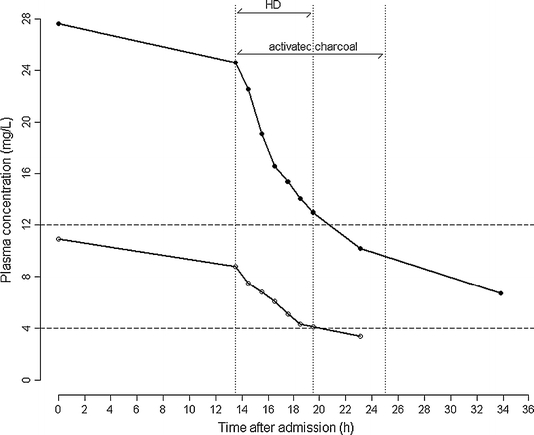Dear Editor,
A 61-year-old woman (patient A) was admitted to our intensive care unit with carbamazepine overdose. Carbamazepine total plasma concentration determined by enzyme-multiplied immunoassay technique (EMIT) was 52.5 mg/L (reference 4–12 mg/L) of which 22.7 mg/L was unbound (43%). Unbound carbamazepine was determined in plasma by EMIT after ultrafiltration (Amicon Ultra centrifugal filter (Millipore), 2,500 rpm, 30 min at 25°C). Despite supportive care (pacemaker, inotropes and vasopressors) and multiple activated charcoal administration, the patient died shortly after admission as a result of refractory shock.
Soon after, a 41-year-old man (patient B) was admitted after resuscitation due to ventricular fibrillation. For epilepsy he was treated with carbamazepine (400 mg 5 times/day). As a result of repeated ventricular fibrillation, intravenous amiodarone (300 mg/day) was started. Two days later a deep coma developed. Because of a high daily dose of carbamazepine and its interaction with amiodarone, we suspected a carbamazepine intoxication. Total carbamazepine plasma concentration was 27.4 mg/L of which 10.9 mg/L was unbound (40%). Carbamazepine intoxication was treated with multiple-dose activated charcoal and high-flux haemodialysis (HF-HD); filter Fresenius Helixon® FX1000, blood flow 350 mL/min, dialysate flow 500 mL/min, ultrafiltration rate 120 mL/h, ultrafiltration coefficient 75 mL/(h mmHg). Carbamazepine plasma concentration decreased to 13.0 mg/L (4.1 mg/L unbound; 32%) (Fig. 1). The patient fully recovered.
Fig. 1.

Carbamazepine total (solid circles) and unbound (open circles) plasma concentrations in patient B. Therapeutic range for total plasma concentrations 4–12 mg/L
Treatment of carbamazepine intoxication consists of supportive care, prevention of further absorption and enhancement of elimination via haemoperfusion [1, 2]. But haemoperfusion has serious adverse effects and the facilities are often not available [1, 3]. Effectiveness of haemodialysis depends on drug characteristics, dialysis system properties and dialysis conditions. Haemodialysis in carbamazepine overdose is considered not to be efficacious because of low hydrophilicity (Log P = 1.98) and the high degree of protein binding (70–80%), although carbamazepine is small enough for filtration (236 Da) and has a low distribution volume (0.8–1.8 L/kg) [1].
Elimination rate constants (k), calculated as k = ln 2/half-life (h), reflect the effectiveness of the elimination route. Overall k is defined as the sum of all individual k values. Calculated individual k values in patient B were 0.009/h for endogenous metabolism, 0.059/h for dialysis (including membrane adsorption) and 0.039/h for charcoal treatment. Endogenous k was calculated from the time period in which no activated charcoal or HF-HD was applied. k of activated charcoal was calculated by subtracting k endogenous from k overall when only endogenous clearance and activated charcoal therapy were present. k dialysis is k overall during HF-HD minus k endogenous and k activated charcoal. Limited blood sampling during the initial rapid clearance of free drug from the plasma by HF-HD may partly hamper the interpretation of the results. However, on the basis of the half-life initially and later on during HF-HD, we assume that no significant rapid initial phase took place (see Fig. 1).
HF-HD was more effective than multiple activated charcoal treatment alone, whereas the combination of both was about ten times more effective than endogenous clearance. Probably, endogenous k was decreased because of the presence of amiodarone, a CYP3A4 inhibitor [4]. Owing to the increased unbound drug concentration in carbamazepine intoxication, HF-HD proved to be an effective extracorporeal elimination technique.
In conclusion, HF-HD is an effective extracorporeal elimination technique in carbamazepine intoxication as a result of the increased unbound drug fraction and can replace haemoperfusion.
Open Access
This article is distributed under the terms of the Creative Commons Attribution License which permits any use, distribution, and reproduction in any medium, provided the original author(s) and the source are credited.
Contributor Information
M. A. Sikma, Email: msikma@umcutrecht.nl
J. Meulenbelt, Email: J.Meulenbelt-1@umcutrecht.nl
References
- 1.Garlich FM, Goldfarb DS. Have advances in extracorporeal removal techniques changed the indications for their use in poisonings? Adv Chronic Kidney Dis. 2011;18:172–179. doi: 10.1053/j.ackd.2011.01.009. [DOI] [PubMed] [Google Scholar]
- 2.Bek K, Kocak S, Ozkaya O, Yilmaz Y, Aydin OF, Tasdoven CS. Carbamazepine poisoning managed with haemodialysis and haemoperfusion in three adolescents. Nephrology (Carlton) 2007;12:33–35. doi: 10.1111/j.1440-1797.2006.00663.x. [DOI] [PubMed] [Google Scholar]
- 3.Tapolyai M, Campbell M, Dailey K, Udvari-Nagy S. Hemodialysis is as effective as hemoperfusion for drug removal in carbamazepine poisoning. Nephron. 2002;90:213–215. doi: 10.1159/000049045. [DOI] [PubMed] [Google Scholar]
- 4.Mouly S, Meune C, Bergmann JF. Mini-series: I. Basic science. Uncertainty and inaccuracy of predicting CYP-mediated in vivo drug interactions in the ICU from in vitro models: focus on CYP3A4. Intensive Care Med. 2009;35:417–429. doi: 10.1007/s00134-008-1384-1. [DOI] [PubMed] [Google Scholar]


